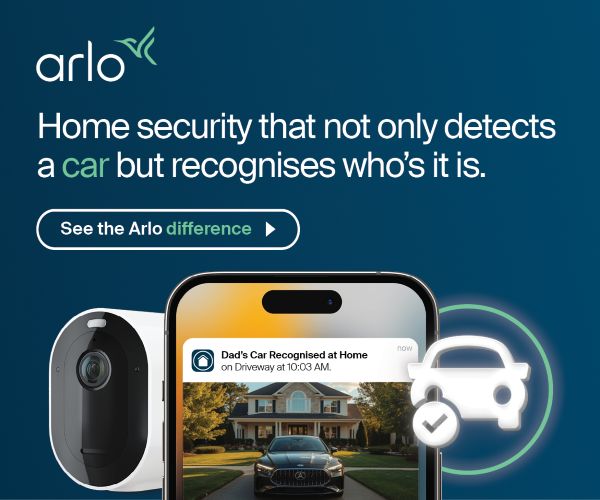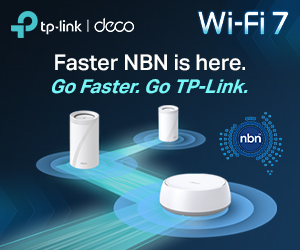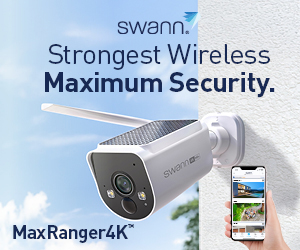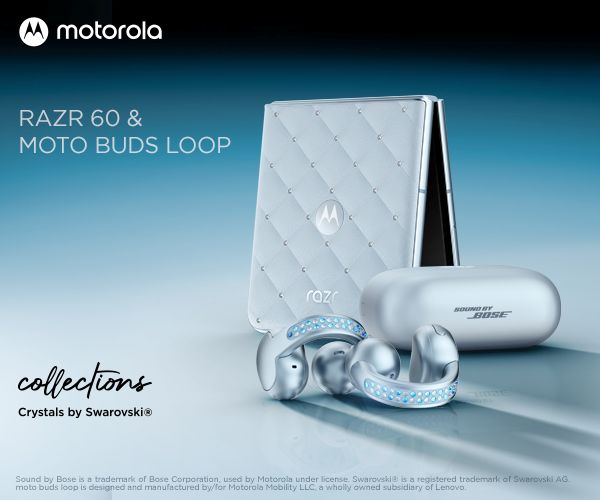The TP-Link Archer BE800 Wi-Fi 7 BE19000 is a BEast of a router – in the best way possible. It is big, bold, and powerful, with a design that says, ‘Bring it on’.
OK, enough hype, but I mean it – TP-Link have taken Wi-Fi 7 to the extreme. The only thing that is perhaps a little more awesome is its GE800 BE19000 Gaming router with a dedicated game panel and RGB lighting – it looks at home in a Star Wars movie.
If you don’t need all the speed, it has a smaller version, Archer BE550 BE9300 Tri-band Wi-Fi 7 router at $549, which does much the same but has less bandwidth. It is also EasyMesh capable (see later).


Before we get into the Archer BE800 Wi-Fi 7 review, here are a few key features.
- Interesting front LED screen.
- Qualcomm’s Networking Pro 1220 Wi-Fi chip, 1GB RAM, 256MB flash storage, 2.2GHz quad-core processor.
- 1× 10 Gbps Ethernet/SFP+ Fiber Combo WAN/LAN port multi-link.
- 1 × 10 Gbps WAN/LAN port.
- 4× 2.5 Gbps ports (can aggregate two to 5Gbps).
- 1× USB 3.0 port (NTFS, exFAT, HFS and FAT32 – tested to 2GB).
- 12-stream, 4×4 MIMO, OFDMA, 4K-QAM, MLO, Multi-RUs, DFS, 1 x 320MHz channel
- Tri-Band 2.4GHz (1376Mbps), 5GHz 5760Mbps and 6GHz (11520Mbps but limited by the ACMA to 4800Mbps in Australia) for a total of 11,936Mbps BE12000. See Wi-Fi 7 BE – what it means to you).
- Flexible SSID allocation, including IoT and Guest networks (see later)
- Eight beamforming antennae with AI Wi-Fi optimisation.
- Easy Mesh compatible for simple expansion.
- HomeShield Trial (subscription after that).
- Voice Assistants – Google Home and Alexa.
- Comprehensive web interface (all expected advanced settings) and TP-Link Tether App.
Consumer Advice: Router or Mesh?
All Wi-Fi has a finite circular transmission limit. The 2.4GHz band (now mainly used by IoT devices like security cameras) can transmit up to a radius of 30 metres around the router. The 5GHz band is about 10-15m. The 6GHz band is about 7-10m. These distances are effectively halved when the signals penetrate walls, floors, cupboards, or windows.
Before full-duplex Wi-Fi 6, I would have taken a powerful router over a mesh system any day. Today, the selection is more about use cases and home design.
This review is for a router. Think of it as a V8 car engine – raw power on demand. It suits power users, gamers, 4/8K video streaming, AR, and, in this case, up to 100 connected devices. For about $1000, it offers maximum bandwidth and power. EasyMesh can expand its reach.
A similar mesh system like the TP-Link Deco BE85 Wi-Fi 7 BE22000 tri-band mesh router costs about $1k per router and the same per satellite node. You probably will need at least two or three to cover a larger multi-level home.
Consumer Advice: Don’t buy grey market – it likely won’t work here
Because Australia only has 500Mhz of the 12000MHz 6GHz Wi-Fi 7 band (42% and one 320Mhz band instead of three), its firmware and Wi-Fi transmission strengths differ. There is a lot more power and bandwidth that could be unlocked if ACMA would approve it.
You can quickly tell if the router has an R-NZ C-Tick on the external box and the sticker under it. Wikipedia has the approved country bands (look at 6Ghz).
TP-Link can update Australian firmware if the ACMA releases more 6GHz bandwidth.
Australian Review: TP-Link Archer BE800 Wi-Fi 7 BE19000 router tri-band mesh router
| Website | AU Website Product User Guide |
| RRP 17/02/24 | $999 |
| From | Harvey Norman, Joyce Mayne, Bing Lee, Officeworks, Good Guys, and specialist computer stores, including MWave, Scorptec, and Umart. Also, via store TP-Link Amazon store. |
| Warranty | 3-year ACL if purchased from authorised resellers. |
| Made in | China |
| Company | TP-Link (Est 1996) is a privately owned Chinese company headquartered in Hong Kong, and its main factory is in Shenzhen. It does not use 3rd-party ODM/OEMs; it designs and manufactures everything in-house. Its Indian factory will, by the end of 2024, make 100% of the products sold there and a substantial amount for export. Products include high-speed cable modems, wireless and mobile routers, range extenders, switches, IP cameras, powerline adapters, switches, print servers, media converters, wireless adapters, power banks, USB Hubs and SMART home technology devices. Brands include Archer routers, Deco mesh, Omada (business networking) and Tapo (Smart home). TP-Link USA is one of the largest home network suppliers from its California base. According to IDC, TP-Link has held the #1 home networking market share (about 20%) in over 170 countries by volume since 2010. |
| More | CyberShack TP-Link news and reviews CyberShack network news and reviews |
We use Fail (below expectations), Pass (meets expectations) and Exceed (surpasses expectations or is the class leader) against many of the items below. We occasionally give a Pass(able) rating that is not as good as it should be and a Pass ‘+’ rating to show it is good but does not quite make it to Exceed. You can click on most images for an enlargement.
First Impression – Imposing with an intriguing readout – Pass+
When was the last time a router smiled at you? The Archer BE800 Wi-Fi 7 can. Its front is perforated (like a speaker grille), and it can pulse various white LED emojis that are occasionally useful – or turn them off.
It looks solid with thick, flat, metallic sides punctuated by a V-channel in the middle and large at 302× 262.5 × 96 mm x 2.16kg.
It has six multi-gig Ethernet ports (one shared with SFP+) and materially improved Wi-Fi speeds with a mix of 2.4/5/6GHz clients. You would buy this for future-proofing, as Wi-Fi 6E and 7 devices are still relatively scarce.
Setup – Pass+
The easiest and recommended way is to download the TP-Link Tether App for Android or iOS. It will guide you through the simple steps to get this performing. Accept all defaults, although it presents you with a few choices.
It requires a TP-Link user account, which has the usual Privacy implications. From our reading, they are relatively benign.
We won’t go through the straightforward setup as the app guides you.
Or you can access the web interface http://tplinkwifi.net with the router SSID password (that you change after first use) and use the Quick Setup Wizard. The web interface opens up a comprehensive, advanced router configuration.









SSID Choices – Exceed
The most important is how many bands to enable. By default, the Archer BE800 Wi-Fi 7it transmits (we will use XXX as the example SSID).
- Combined (Smart Connect) 2.4 (20/40MHz) and 5GHz (20/40/80Mhz) SSID. You can select the 20/40/80/160MHz option, but it may overlap with DFS channels (military/radar) and the router checks that it meets local regulatory radar detection requirements. Recommended. Shows XXX – set it to WPA-2 encryption.
- Or Separate 2.4GHz and 5GHz SSID. Set the 2.4GHz to WPA-2 and 5GHz to WPA3. Shows XXX and XXX_5G.
- 6GHz 20/40/80/160/320MHz, WPA3 that can only be seen by Wi-Fi 6E and 7 devices. Recommended. Shows XXX_6G.
- Separate 2.4GHz as well as a 5GHz IoT network. Recommended if you are having trouble connecting some older IoT devices. Shows XXX_IOT_2G and XXX_IOT-5G.
- An MLO network that aggregates the bands to offer the best throughput. MLO aggregates multiple channels across different frequency bands into a single connection to provide a superior user experience for recent Wi-Fi 6/6E/7 devices. Recommended.
- Guest networks can be enabled for separate 2.4GHz, 5GHz and 6GHz. Don’t enable it unless you want this. Shows XXX-Guest and XXX_Guest-5G.
Router or Access Point?
There is a lot of bad advice on the internet, especially about creating a ‘double NAT’ (two routers connected), so let’s address this. A router has full functionality. An Access Point loses router functionality and retransmits a new SSID. You want a router!
Most will connect the BE800 to an NBN gateway modem (FTTP, FTTC), as <30% have Ethernet-connected FTTP or HFC cable. If you have the latter, follow the HINT below, but you will remove the old router, so you don’t have to perform #2.
The Gateway is usually a low-speed VDSL2+ modem/Wi-Fi router/VoIP (if you have a landline, you need to keep this modem anyway). Connect the BE800 in router mode via Ethernet cable from the gateway LAN port to the BE800 Internet port. But you end up with two different sets of SSIDs and Wi-Fi interference.
HINT:
#1 Before you connect the BE800, go to the existing gateway router and write down the SSIDs (there may be two or three for 2.4/5/6Ghz) and passwords.
#2 Go to its wireless section and disable Wi-Fi on all the above bands. Note that before you hit SAVE, the only way to access this gateway in future will be via an Ethernet-connected PC/Mac.
#3 Now, the low-powered gateway router is simply supplying Internet access to the BE800. Then, using the old SSID and passwords, all your existing devices will reconnect to the BE800 (you may have to power down/up some devices).
Ports and WAN/LAN Speeds
While most suffer with NBN FTTN up to 100Mbps, it can have up to 10Gbps WAN connection via Ethernet or SFP+ (Fibre). In addition:
- 10Gbps Ethernet LAN – good for connecting to a 10Gbps switch or hub.
- 4 x 2.5Gbps LAN – Connect bandwidth-hungry devices by Ethernet if you can and keep them off Wi-Fi.
- USB-A 3.0 5V/.9A/4.5W – good for LAN storage. Should support an external flash drive or SSD (Tested Kingston XS1000 2TB USB-C 3.2 Gen 2 external SSD)

Placement – take care – Pass+
Its novel, imposing, and, some may say, polarising design means it is a desktop placement (approx. 1m from the ground) only in a central location – critical for the best performance from any router. Read Fix Wi-Fi blackspots fast and often at no cost.

The eight antennae (four in each top Left and Right section) radiate the Wi-Fi signal at about a 45+45° angle to give floor-to-ceiling 2D coverage. Penetration through the adjacent floor or ceiling above is limited, and that is where Mesh, especially with Ethernet wired backhaul, would be used.
Connect Wi-Fi hogs (like 4K TVs, etc.) via Ethernet or hub/switches.
Coverage and load – Pass+
Despite its raw power, the area coverage is limited as per all Wi-Fi routers (maximum line-of-sight radius used)
- 2.4Ghz – 30m radius or 2800m2
- 5Ghz – 20m radius or 1200m2
- 6Ghz – 10m radius or 300m2 (Until ACMA untethers the 6GHz band the reality is closer to a circle 100m2)
The problem is that most homes are not round. The typical modern home is about 30m long x 15m wide or 450m2. A lot of Wi-Fi coverage is wasted and ends up leaking outside.
We tested with about 40 IoT devices, and response times were almost instant – something earlier Wi-Fi 5 or 6 routers could not achieve. TP-Link claims up to 100 devices.
Router Tests – Pass+
- As most of Australia has <100Mbps download (10% of the slowest Gigabit backhaul), you will get whatever the router/gateway is connected to – Pass
- Wi-Fi network speeds are affected by available bandwidth and loads. Fire up multiple 4K streams (3 x 4K TVs playing, UHD from Netflix or Prime Video – two Ethernet and one Wi-Fi 6) – no impact. Add network speakers (Sonos multiroom ten speakers), all belting out at decent volumes – no impact. The BE800 handles Wi-Fi congestion better than any other to date.
- The ‘apparent’ Mbps speed between the Wi-Fi device and the router is a ‘bragging rights’ measurement. All is good if the signal speed is higher than the Internet speed. That is until you get Gigabit internet. The only real advantage of high Wi-Fi speeds is accessing devices on the home network, like network storage.
- Coverage – how much area can the router cover? The antenna design radiates in a circle at about a 45+45=90° angle, covering a typical home’s floor-to-ceiling.
Router Speed and connection tests 5 and 6GHz (Samsung S24 Ultra)
(L) is the 6GHz and (R) is the 5GHz download/upload internet speeds. This shows that 6GHz drops quickly as you move further away. The 5m Walls and 10m LOS (line-of-sight) are similar and demonstrate how 6GHz is more affected by walls.
5GHz is far more stable, with almost no difference between speeds.


These are the 6GHz test results. (images in order)
- WiFi Phy Rx is the speed to the router. It is a maximum of 2400Mbps
- Signal Strength is -dBM (lower is better) is usable to about -70dB
- Download/Upload speed cannot be much more than 100/20 on the test NBN. 6GHz could only achieve that at 2m.
- For those more visually oriented, the final three images are graphic representations.






The second set is the 5GHz test.
- WiFi Phy Rx Speed is more consistent and better through walls
- Signal strength is superior to 6GHz
- Download/upload speeds exceed 100/20Mbps.






This shows two things. First, 6GHz is more affected by distance from the router and obstructions. Second, router placement, if using a 6GHz backhaul extender, is critical and ideally needs to be 5-6m line-of-sight.
Router Test Port Speeds (Cat 6a)
Tested with GEEKOM Mini IT13 PC – big power, small box.
- 2.5Gbps LAN ports deliver up to 2300Mbps – Pass+
- 10Gbps LAN ports deliver up to 8200Mbps – Pass+
- Aggregate two 2.5Gbps ports deliver 4200Mbps – Pass+
- USB-A 3.0 (5Gbps/125MBps) delivered up to 150/125MBps sequential read/write – Pass+
These are the fastest speeds we have seen yet for a router.
EasyMesh and TP-Link Archer Wi-Fi 6E RE815XE AXE 5400 Tri-band range extender
The TP-Link Archer BE800 Wi-Fi 7 BE19000 router supports the Wi-Fi Alliance EasyMesh, not to be confused with TP-Link’s OneMesh, although some extenders support both protocols. Nor is it compatible with TP-Link’s Deco Mesh.

The main difference is this new protocol supports default Wi-Fi and optional Ethernet backhaul (not all devices have this firmware upgrade yet). Currently, most Ethernet extenders revert to Access Point mode with a separate SSID. You don’t want that for seamless roaming.
There are no Wi-Fi 7 EasyMesh extenders yet, but we have the TP-Link Archer Wi-Fi 6E RE815XE AXE5400 Tri-Band EasyMesh Range Extender for review.
It offers 2.4GHz (574Mbps), 5GHz (2402Mbps) and 6GHz (2402Mbps) and has 20/40/80/160MHz wide channels. It uses 1200Mbps of the 6GHz band for backhaul (with a 6GHz router), giving it excellent backhaul speed, albeit at a limited range. It is for connection to Wi-Fi 6E and 7 routers only.
This plugs into a power socket and covers a double socket. The Tether App finds it and joins the router. At present, this does not support Ethernet backhaul (planned).

EasyMesh Tests – Placed 5 metres away through 2 plasterboard walls and two built-in cupboards
- Full NBN 100/20Mbps and 15-18ms connect (typically about 9-12ms at the router).
- Samsung S24 Ultra (Wi-Fi 7) connects to the combo 2.4/5Ghz band and 6GHz band at around 18ms (usually 12) and can access the internet at full speed. This extender does not support MLO or 320MHz aggregation Wi-Fi 6E or 7 devices connected at up to 2400Mbps. Wi-Fi 6 devices connect at 1200Mbps on the 5GHz band.
- The range is good. The 4 antennae cover 2.4GHz to 20m, 5GHz to 10m, and 6GHz to about 5m. However, walls and obstructions are an issue – line-of-sight is better.
The thing to remember with a range extender is that it is not the same as full-fledged Mesh, where the router and satellites have the same capability and speeds and offer a range of extra SSIDs. EasyMesh retransmits the signal strength it receives until it gets Ethernet backhaul.
HomeShield – Not Tested
The free version can set:
- Network Scan
- QoS
- Kids internet times (based on profiles)
- Content filtering
- Usage analysis
Advanced features require a subscription. Please click the heading to go to the HomeShield Page.
Voice Assistants – Pass
It supports Google Home and Alexa. Commands are limited (L Google) and (R Alerxa) but improving:


Power – Pass+
The BE800, when Idling (no actual load), consumes <20W, but we never saw peaks above 50W. The power adapter is 15VF/5A/75W, indicating that it could use more power.
The RE815XE Extender uses about 20-25W regardless of mode.
There are no sleep settings for either. At current energy rates, it uses 40c per KWh (50 hours for 40 cents) plus an extender if required.
LED readout – Pass
It can play preset emoji faces, add custom animations (you must create these) or Text. We added the time and weather emojis and enabled location (checked).

CyberShack’s view – TP-Link Archer BE800 Wi-Fi 7 Tri-Band BE19000 router stands for BEast and BEst.
Not to in any way suggest that Wi-Fi 7 BE 19000+ routers from $1499 Netgear RS700S Wi-Fi 7 BE19000 tri-band router is fast, very fast or $1499 ASUS (GT-BE98 – review coming) are inferior but to suggest that despite using the same Qualcomm Wi-Fi processor they all are slightly different. For starters, this costs $999 – 33% less, there are no compromises, and it meets or exceeds all our Wi-Fi 7 tests. On that basis alone, it is a winner.
Why buy Wi-Fi 7?
Don’t rush out if you have a Wi-Fi 6 or 6E router. It is likely these will last you until Wi-Fi 8 comes out in late 2025/early 2026, and who knows what magic that will bring.
If you have Wi-Fi 5 AC or earlier or your ISP-supplied current router is not up to speed, then for $999, the Archer BE800 Wi-Fi 7 is the perfect router to add to that and get superb Wi-Fi speeds and carry big loads. Of course, you will still have the same NBN speed, but the Wi-Fi 7 router will manage that far more effectively.
Archer BE800 Wi-Fi 7 rating
We did not rate the Netgear RS7000S as it was our first Wi-Fi 7 router, so we have gone back and done so. It scored 88/100, losing a few points for RRP $1499 and Gigabit versus 2.5Gb LAN ports.
- Features: 90 – Qualcomm Wi-Fi processor, fully featured OS and the Tether App can access most of the web settings.
- Performance: 90 – Better than expected Wi-Fi 6GHz range and superb router coverage.
- Value: 90 – It is 33% cheaper than the closest competitor yet does not compromise in any way.
- Ease of Use: 90 – simple set-up, great warranty and excellent local support.
- Design: 85 – love or hate it, it is unique
CyberShack Verdict
TP-Link Archer BE800 Wi-Fi 7 Tri-Band BE19000 router
$999














Comments